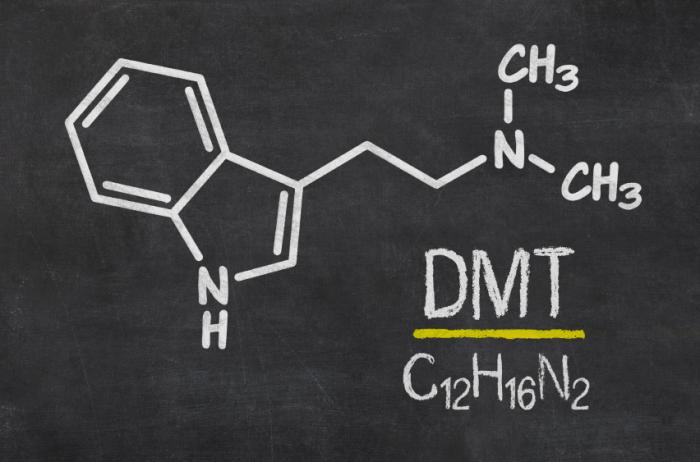DMT, or N,N-Dimethyltryptamine, is one of the most powerful and potent Psychedelics discovered by humankind. Its psychotropic effects were discovered by Stephen Szara in the mid-1950s. This is the only psychedelic compound that is naturally found in the human body. Hundreds of plants and animals, from underwater organisms to land mammals, produce DMT naturally. DMT is best known as the active hallucinogenic compound in the Holy Medicine of the Holy and Divine Mother Ayahuasca, which is generally made by a combination of Banisteriopsis Caapi Vine and Psychotria Viridis Leaves and consumed during Sacred Ceremony by the indigenous people of the Amazons and now globally.
DMT is not just another recreational drug. It is the most powerful Psychedelic compound that has the potentiality to alter the human consciousness. For this reason, this mystical substance is also known as ‘the Spirit Molecule.’ The molecule is also known as ‘Dimitri,’ and for delivering an intense Psychedelic experience within 20 minutes, this substance is also known as ‘Businessman’s Trip’ and ‘Fantasia’.
1931 – Discovery of DMT
Despite its presence in the human pharmacopeia for millennia, humans are yet to resolve the biochemical mechanisms by which this hallucinogen so dramatically alters perception and consciousness. Though it is evident that for thousands of years, DMT has been used in Shamanic ceremonies around the South American countries, it did not arrive in the Western countries until much later in 1931 when a Canadian chemist Richard Manske first synthesized DMT, but the psychedelic nature of DMT was not assessed at that time.
1946-1956 – Discovery of the psychedelic nature of DMT
Unraveling the mysteries of this molecule happened gradually. In 1946 microbiologist Oswaldo Goncalves de Lima discovered that this molecule occurs naturally in certain plants. Still, the hallucinogenic properties of DMT were not discovered. Ten years later, in 1956, a Hungarian psychiatrist and chemist Stephen Szara extracted DMT from a Mimosa Hostilis plant and administered it to himself inspired by visiting South American religious ceremonies. That was the first drug that induces hallucinations, distortions of spatial perception and body image, illusions, euphoria, and disturbances of thoughts in humans.
1950s – 1960s – Research
The discovery of some hallucinogens in the 1950s and the observations of their effects on behavior and perception prompted hypotheses that schizophrenia syndrome might be caused by an error in metabolism that produced those hallucinogens in the human brain. In 1952 Osmond and Smythies began exploring the connection between DMT levels in the patients with psychosis and those without it, but no solid connections were made. Following the acts of the Controlled Substances Act in 1970, all of the research into DMT and other psychedelics waned in both Europe and the United States for many years.
1972 – Evidence of DMT producing enzyme in human brain tissue
In 1961, Nobel laureate Julius Axelrod discovered an indole-N-methyl transferase in the rat brain. At that time, researchers already started to examine whether the conversion of tryptophan to tryptamine could be converted to DMT in the brain and other tissues from other mammalian species. Many studies subsequently showed the biosynthesis of DMT in mammalian tissue preparations in vitro and vivo by Juan Saavedra and Julius Axelrod.
In 1972, both of these researchers reported that intracisternally administered tryptamine (TA) was converted to N-methyltryptamine and DMT in the rat, the first demonstration of DMT’s formation by brain tissue in vivo using centrifuged and dialyzed whole-brain and homogenate supernatant from rats and human.
1990s – Research by Rick Strassman
In the 1990s, Rick Strassman, an American clinical associate professor of psychiatry at the University of New Mexico School of Medicine, started doing the first research on humans. He pioneered contemporary research into Psychedelic substances with the belief that the profound effect of DMT on consciousness warranted further exploration. Around that time, he published several landmark study reports, including detailed dose-response experiments using the Hallucinogen Rating Scale to measure individual experiences.
Based on his 20 years of research he published The Spirit Molecule in 2000, which was widely considered a landmark book on DMT.
1998 – Dennis McKenna research with Holy Medicine of the Holy and Divine Mother Ayahuasca
In 1988, Dennis McKenna linked all these sequences of events of discovering DMT and its hallucinogenic properties with the ancient usages of DMT in Amazonian countries long before it was discovered and started his Scientific Investigation of Ayahuasca and its effects on the psyche and published his research.
When did DMT become mainstream?
Back in 1960s, William Burrough, a famous author, visited Peru in search of Yage, and later his experiment and experiences with hallucinogens he, with another famous author who advocated Psychedelics, Timothy Leary, began corresponding back and forth about hallucinogens. Later, Timothy Leary, along with few researchers Ralph Metzner and Richard Alper, were credited for being responsible to make DMT popular as Psychedelic. Leary, Metzner, and Alper documented many of their experiences and observations about how the experiences with DMT can differ depending upon set and setting. Ultimately their works in the early 1960s pushed DMT into the spotlight and produced a world full of experimenters. It is reasonable, therefore, to attribute the widespread usages and experiences of DMT today to their initial research work.
References:
- National Geographic. (2019). Ancient hallucinogens found in 1,000-year-old shamanic pouch. [online] Available at: https://www.nationalgeographic.com/culture/article/ancient-hallucinogens-oldest-ayahuasca-found-shaman-pouch [Accessed 2nd May 2021]
- Saavedra JM, Axelrod J. (1972). Psychotomimetic N-methylated tryptamines: formation in brain in vivo and in vitro. National Library of Medicine, [online] Volume 24;175(4028), p. 1365-6. Available at: https://pubmed.ncbi.nlm.nih.gov/5059565/ [Accessed 2nd May 2021]
- Szara, S. (1956). Dimethyltryptamin: its metabolism in man; the relation to its psychotic effect to the serotonin metabolism. National Library of Medicine, [online] Volume 15;12(11), p. 441-2. Available at: https://pubmed.ncbi.nlm.nih.gov/13384414/ [Accessed 2nd May 2021]
- Strassman, Rick. (1991). A report on FDA approved human studies with DMT. MAPS, [online] Available at: https://maps.org/news-letters/v03n1/03107dmt.html [Accessed 2nd May 2021]


